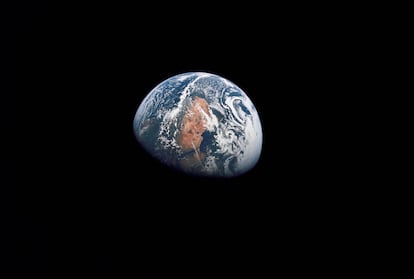How do you convince a flat-earther that our planet is really round
Here are five arguments that explain why it is impossible for the Earth to be flat

It is the flat-earthers the ones who would have to refute the roundness of the Earth, because the current evidence shows that the planet is round. By now, humans have explored and measured the planet in a thousand different ways; airplanes fly between all points of the map and the distances are well known. There are about 5,000 satellites orbiting the Earth, taking daily photos that show the planet is round. However, many flat-earthers claim that all these images are fake. But the debate is no longer scientific if we cannot trust the evidence offered by others; imagine having an orange in front of your eyes while the flat-earthers tell you that what you see lacks credibility and insist that the orange is flat.
The Earth has been known to be round for more than 2,000 years, long before the satellites and the first circumnavigation of the world. There is much mathematical evidence that the Greeks calculated thanks to their knowledge of geometry and navigation – however, here we presented just five simple, easily verifiable arguments that explain why it is impossible for the Earth to be flat.
First: Everybody knows that the higher we go, the further we can see. If the Earth was flat, this would not be the case, as you would be able to see all the way to the end of the planet from any place without relief, even the sea. With a powerful telescope you would see from New York to Madrid. But that is not possible, due to the curvature of the surface of the Earth. This has been known since ancient times, and that is why lighthouses are placed on top of a tower so that they are visible from a greater distance. And vice versa: if you are in a port and you watch a ship arrive, first you will see the mast – the highest part of the ship – appear, then the sails, and finally the hull.
Second: The times of sunrise and sunset are different in every part of the world. If you think about it, this would not be the case on a flat Earth. Moreover, and in relation to the previous point, the time at which the sun sets in each place also depends on the height from which you look at the horizon. Islamic astronomers studied this very well. Tables with sunset times are available online for almost every place in the world, so people can know exactly when to break the Ramadan fast. If you look for information for Dubai, you will learn that in the Burj Khalifa building, which at 2,717 feet high is the tallest in the world, the sun sets three minutes later on the highest floor than on the lowest. This would not happen on a flat planet either.
Third: On a flat, non-rotating Earth, the water would go directly towards the center of the sink, the same everywhere. But that is not the case. When you empty a sink (even better if it is a large, round pool) a whirlpool is formed. That happens thanks to the Coriolis effect, which can only be explained by the rotation of the Earth. Flat-earthers may argue that a flat Earth could also rotate on its axis and that this could generate a whirlpool like the one we see. The problem is that the eddies of the pools rotate in opposite directions in the two different hemispheres (storms and anticyclones too). For that to happen on a flat Earth, we would need two opposing rotating poles that would each affect half of the Earth.
Fourth: The movement of the night sky. This argument is similar to the previous one. In the northern hemisphere, the entire night sky rotates counterclockwise around the North Star, while in the southern hemisphere, everything revolves around the Southern Cross, in the opposite direction. For that to be the case on a flat Earth, we would need two celestial spheres, one for each hemisphere, rotating in opposite directions.
Fifth: The duration of long trips is different whether you travel east or west. This fact has no explanation on a flat Earth. The following are very different examples, but both have to do with a spherical Earth that rotates around its own axis. A fairly common example is that the flight from Madrid to New York takes longer than the one from New York to Madrid, because the latter is aided by the jet stream that goes eastward and has its origin in the rotation of the Earth. The other argument is based on the Circumnavigator’s Paradox, which says that if you go around the world, the journey will not take the same time if you go west than if you go east. In this case, it does not matter how long it takes you to go all the way around: if you travel east you will gain a day, like Phileas Fogg did in Jules Verne’s Around the World in Eighty Days, while if you travel west you will lose it, like Elcano and his crew at the end of the first circumnavigation. This paradox would be impossible to explain on a flat Earth where the sun rises at the same time for everyone and everyone shares the same calendar date.
Tu suscripción se está usando en otro dispositivo
¿Quieres añadir otro usuario a tu suscripción?
Si continúas leyendo en este dispositivo, no se podrá leer en el otro.
FlechaTu suscripción se está usando en otro dispositivo y solo puedes acceder a EL PAÍS desde un dispositivo a la vez.
Si quieres compartir tu cuenta, cambia tu suscripción a la modalidad Premium, así podrás añadir otro usuario. Cada uno accederá con su propia cuenta de email, lo que os permitirá personalizar vuestra experiencia en EL PAÍS.
¿Tienes una suscripción de empresa? Accede aquí para contratar más cuentas.
En el caso de no saber quién está usando tu cuenta, te recomendamos cambiar tu contraseña aquí.
Si decides continuar compartiendo tu cuenta, este mensaje se mostrará en tu dispositivo y en el de la otra persona que está usando tu cuenta de forma indefinida, afectando a tu experiencia de lectura. Puedes consultar aquí los términos y condiciones de la suscripción digital.
More information
Últimas noticias
The United States warns it will deprive Maduro of ‘the resources he uses to fund’ drug trafficking
Chris Martin, Taylor Swift, Elijah Wood and other famous wedding ‘crashers’
‘How does it feel to be a failure?’: Elizabeth Berkley’s journey from ‘Showgirls’ ridicule to vindication
The story of the Málaga virus: The code that haunted Google’s cybersecurity center director for 30 years
Most viewed
- Christian Louboutin: ‘Young people don’t want to be like their parents. And if their parents wear sneakers, they’re going to look for something else’
- Liset Menéndez de la Prida, neuroscientist: ‘It’s not normal to constantly seek pleasure; it’s important to be bored, to be calm’
- December Social Security and SSI payments: Dates, double checks and the 2026 COLA increase
- The low-cost creative revolution: How technology is making art accessible to everyone
- All the effects of gentrification in one corner of Mexico’s Colonia Roma










































